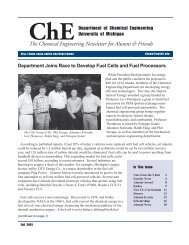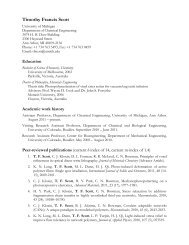Making Oil at Warp Speed - Chemical Engineering - University of ...
Making Oil at Warp Speed - Chemical Engineering - University of ...
Making Oil at Warp Speed - Chemical Engineering - University of ...
You also want an ePaper? Increase the reach of your titles
YUMPU automatically turns print PDFs into web optimized ePapers that Google loves.
Understanding N<strong>at</strong>ure Using Simul<strong>at</strong>ions<br />
Pr<strong>of</strong>essor Ronald Larson and recent PhD<br />
gradu<strong>at</strong>e, Dr. Susan Duncan (above)<br />
are using advanced molecular dynamics<br />
simul<strong>at</strong>ions to help understand how<br />
lung surfactant works.<br />
The inside <strong>of</strong> the lung contains<br />
millions <strong>of</strong> small air-filled sacks called<br />
alveoli, which provide a large surface<br />
area for absorbing oxygen into the<br />
blood. These alveoli, which expand<br />
and contract considerably each time we<br />
inhale and exhale, are lined with a layer<br />
<strong>of</strong> lung surfactant—a mixture <strong>of</strong> lipids and<br />
proteins th<strong>at</strong> reduces and regul<strong>at</strong>es the<br />
surface tension.<br />
Without functional lung surfactant,<br />
the work <strong>of</strong> bre<strong>at</strong>hing is too hard to<br />
perform, resulting in respir<strong>at</strong>ory distress<br />
syndrome (RDS), the most common<br />
complic<strong>at</strong>ion in prem<strong>at</strong>ure infants and a<br />
leading thre<strong>at</strong> to the survival <strong>of</strong> p<strong>at</strong>ients<br />
suffering from lung injury.<br />
Although surfactant replacements<br />
have gre<strong>at</strong>ly reduced the mortality r<strong>at</strong>e<br />
<strong>of</strong> neon<strong>at</strong>al RDS, current replacements<br />
are not optimal and acute RDS in<br />
p<strong>at</strong>ients suffering from lung injury has<br />
proven more difficult to tre<strong>at</strong>.<br />
Without functional lung surfactant,<br />
the work <strong>of</strong> bre<strong>at</strong>hing is too hard<br />
to perform, resulting in respir<strong>at</strong>ory<br />
distress syndrome (RDS), the most<br />
common complic<strong>at</strong>ion in prem<strong>at</strong>ure<br />
infants and a leading thre<strong>at</strong> to the<br />
survival <strong>of</strong> p<strong>at</strong>ients suffering from<br />
lung injury.<br />
In order to aid the design <strong>of</strong> effective<br />
surfactant replacements, further research<br />
is needed to understand the mechanisms<br />
th<strong>at</strong> promote physiological surfactant<br />
function. To be effective, lung surfactant<br />
layers must perform two seemingly<br />
conflicting tasks: they must be solid<br />
enough to avoid irreversible collapse<br />
upon compression, and fluid enough<br />
to adsorb and respread readily upon<br />
expansion. Both phase and structural<br />
(reversible collapse) transitions have<br />
been implic<strong>at</strong>ed in this process.<br />
In a recent Biochemica et Biophysica<br />
Acta: Biomembranes article, Susan and<br />
Ron considered the role <strong>of</strong> individual<br />
surfactant components on collapse<br />
transitions in individual layers (called<br />
“monolayers”) <strong>of</strong> lung surfactant. They<br />
used molecular dynamics simul<strong>at</strong>ions,<br />
which allow each molecule in a lung<br />
surfactant mixture to be tracked on a<br />
computer (figure <strong>at</strong> right). The simul<strong>at</strong>ions<br />
showed th<strong>at</strong> the addition <strong>of</strong> lung<br />
surfactant proteins called SP-B and<br />
SP-C had a strong impact on monolayer<br />
collapse, and allowed these monolayers<br />
to fold more readily. In addition, by<br />
“mut<strong>at</strong>ing” the peptides, they discovered<br />
th<strong>at</strong> the peptides needed to be<br />
sufficiently “hydrophobic” to induce<br />
C O L L E G E O F E N G I N E E R I N G / CHEMICAL ENGINEERING / w w w . c h e . e n g i n . u m i c h . e d u<br />
folding—th<strong>at</strong> is, they needed to be<br />
significantly w<strong>at</strong>er-repellant, so th<strong>at</strong> they<br />
would penetr<strong>at</strong>e more deeply into the<br />
surfactant monolayer.<br />
“This research is leading to a better<br />
understanding <strong>of</strong> how lung surfactant<br />
does the marvelous work <strong>of</strong> allowing<br />
each <strong>of</strong> us to take our next bre<strong>at</strong>h,” Ron<br />
says. “And it could help in the design<br />
<strong>of</strong> effective replacements for those who<br />
temporarily lack effective lung surfactant<br />
and are <strong>at</strong> risk <strong>of</strong> dying because <strong>of</strong> it.”<br />
Two fluid monolayers <strong>of</strong> lipid, with a surfactant<br />
protein fragment <strong>of</strong> SP-B (yellow) respond to<br />
compression by buckling and folding (top). After<br />
the simul<strong>at</strong>ion is run longer, fully-developed folds<br />
are evident (bottom). Upon re-expansion the<br />
folds reincorpor<strong>at</strong>e into the monolayer. The two<br />
monolayers are separ<strong>at</strong>ed by w<strong>at</strong>er (shown here as<br />
small white dots).<br />
Ron Larson’s webpage:<br />
www.che.engin.umich.edu/people/larson.html<br />
7





